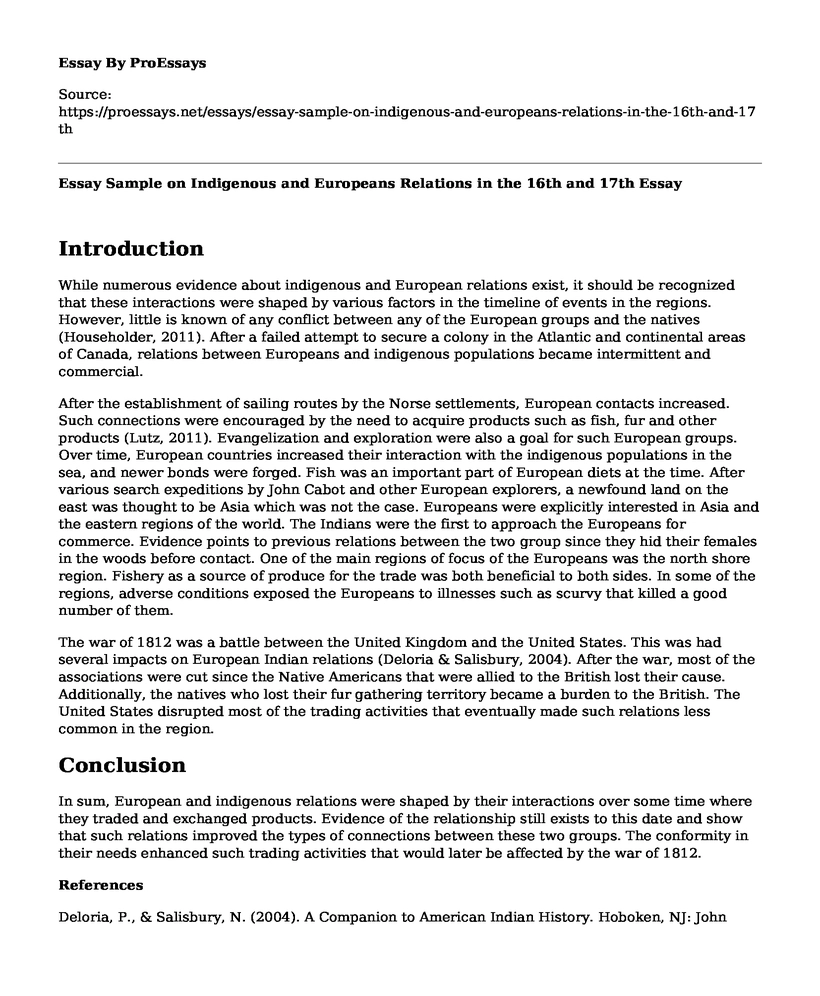Introduction
While numerous evidence about indigenous and European relations exist, it should be recognized that these interactions were shaped by various factors in the timeline of events in the regions. However, little is known of any conflict between any of the European groups and the natives (Householder, 2011). After a failed attempt to secure a colony in the Atlantic and continental areas of Canada, relations between Europeans and indigenous populations became intermittent and commercial.
After the establishment of sailing routes by the Norse settlements, European contacts increased. Such connections were encouraged by the need to acquire products such as fish, fur and other products (Lutz, 2011). Evangelization and exploration were also a goal for such European groups. Over time, European countries increased their interaction with the indigenous populations in the sea, and newer bonds were forged. Fish was an important part of European diets at the time. After various search expeditions by John Cabot and other European explorers, a newfound land on the east was thought to be Asia which was not the case. Europeans were explicitly interested in Asia and the eastern regions of the world. The Indians were the first to approach the Europeans for commerce. Evidence points to previous relations between the two group since they hid their females in the woods before contact. One of the main regions of focus of the Europeans was the north shore region. Fishery as a source of produce for the trade was both beneficial to both sides. In some of the regions, adverse conditions exposed the Europeans to illnesses such as scurvy that killed a good number of them.
The war of 1812 was a battle between the United Kingdom and the United States. This was had several impacts on European Indian relations (Deloria & Salisbury, 2004). After the war, most of the associations were cut since the Native Americans that were allied to the British lost their cause. Additionally, the natives who lost their fur gathering territory became a burden to the British. The United States disrupted most of the trading activities that eventually made such relations less common in the region.
Conclusion
In sum, European and indigenous relations were shaped by their interactions over some time where they traded and exchanged products. Evidence of the relationship still exists to this date and show that such relations improved the types of connections between these two groups. The conformity in their needs enhanced such trading activities that would later be affected by the war of 1812.
References
Deloria, P., & Salisbury, N. (2004). A Companion to American Indian History. Hoboken, NJ: John Wiley & Sons.
Householder, M. (2011). Inventing Americans in the Age of Discovery: Narratives of Encounter. Surrey, England: Ashgate Publishing.
Lutz, J. S. (2011). Myth and Memory: Stories of Indigenous-European Contact. Vancouver: UBC P.
Cite this page
Essay Sample on Indigenous and Europeans Relations in the 16th and 17th. (2022, Nov 17). Retrieved from https://proessays.net/essays/essay-sample-on-indigenous-and-europeans-relations-in-the-16th-and-17th
If you are the original author of this essay and no longer wish to have it published on the ProEssays website, please click below to request its removal:
- September 11's Impact on American Journalism
- Paper Example on HIV Positive Immigrants Travel to the United States
- Essay Example on the Forgotten 500: The Greatest Rescue Mission of WWII
- Essay Sample on The Abolitionist Movement: Ending Slavery and Fuelling Debate
- Essay Example on Risky Ventures: Ignoring the Consequences of Bureaucracy
- Essay Sample on Colonization of America: A Revolution for Freedom and Dignity
- Essay on Colonial Strains: Native-American Relations, Slavery, and Modernity Perspectives







